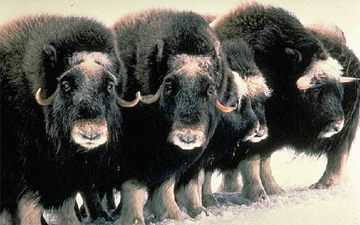The muskox (Ovibos moschatus) is an Arctic mammal of the Bovidae family, noted for its thick coat and for the strong odor emitted by males, from which its name derives. This musky odor is used to attract females during mating season. Muskoxen live primarily in Arctic North America, with small reintroduced populations in Sweden, Siberia and Norway. (From Wikipedia)
– – –
Muskoxen are well adapted to their cold Arctic habitat, with short, stocky bodies and a thick coat of ground-length hair, enhanced in the winter by woolly underhairs for added insulation. They feed on sedges, grasses, and willows. Like other mammals in the family Bovidae, they are ruminants: they gulp down a large quantify of food, then regurgitate and re-chew it at leisure. This behavior – chewing their cud – lets them break down the vegetation and digest it better. It also lets them forage quickly, which may be a protection from predators. Females and young Muskoxen live in mixed-sex groups year-round. Some bulls live alone in the summer, but are likely to join all-male or mixed-sex groups in winter. Bulls breed with several females. Competition involves clashing with horns and their heavily shielded heads. Muskoxen also use their horns in a group defense strategy against their principle predators, wolves and brown bears: they back into a circle or cluster, with head and horns facing outward. Individual animals dart out to charge at the intruder. (From EOL via Smithsonian NMNH)
– – –





